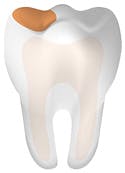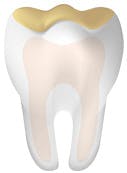The Difference Between Acid Erosion and Cavities
Acid erosion and cavities are not the same—but they can both be harmful to teeth. Acid erosion is a form of tooth wear that is caused by acid softening the surface of the tooth enamel. Cavities are holes in the tooth created by bacterial decay. Here are some of the main differences between cavities and acid erosion:

Cavities
- They form when foods with sugar or starches are turned into acids by the bacteria in the mouth.
- Over time, the acids in plaque can cause the enamel to break down and a cavity to form, which may require filling by a dentist.

Acid Erosion
- Acid erosion can occur across the whole tooth surface that has been exposed to acid.
- It is the result of the interaction of acids (either from food, drinks, or the stomach) on the surface of tooth enamel.
- Acidic softening can weaken enamel over time, putting teeth at risk of thinning, yellowing, dullness, and making them more susceptible to sensitivity.
- Even if your teeth are clean and healthy, you can still experience acid erosion.
Tooth enamel is irreplaceable, so acid erosion presents a risk to your oral health. Since it is not easily detectable to the naked eye, only a dentist can properly assess the effects of acid erosion on your tooth enamel.
Over time, acid erosion can lead to reduced enamel thickness and a change in the shape, texture, and appearance of your teeth. It can also cause your teeth to become sensitive.
Talk to your dentist about acid erosion and what steps you can take to protect your enamel.



